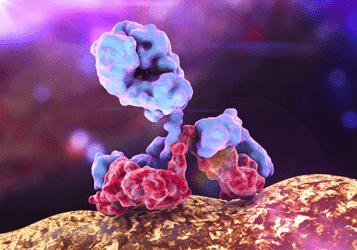- Home
- Products
- Customized ADCs
- IL2RA
- Anti-IL2RA (Basiliximab)-SPDB-DM4 ADC
Anti-IL2RA (Basiliximab)-SPDB-DM4 ADC (CAT#: ADC-W-1365)
This ADC product is comprised of an anti-IL2RA monoclonal antibody conjugated via a SPDB linker to DM4. The DM4 is targeted to certain cancers by immunerecognition and delivered into cancer cells via receptor mediated endocytosis. Within the cell, DM1 binds to tubulins, interrupts microtubule dynamics, and subsequently, induces cell death.
- ADC Target
- ADC Antibody
- ADC Linker
- ADC payload drug
- Name
- IL2RA
- Alternative Names
- IL2RA; interleukin 2 receptor, alpha; IL2R; interleukin-2 receptor subunit alpha; CD25; p55; IL2-RA; IL-2-RA; TAC antigen; IL-2R subunit alpha; IL-2 receptor subunit alpha; TCGFR; IDDM10;
- Target Entrez Gene ID
- 3559
- Target UniProt ID
- P01589
- Overview
- The interleukin 2 (IL2) receptor alpha (IL2RA) and beta (IL2RB) chains, together with the common gamma chain (IL2RG), constitute the high-affinity IL2 receptor. Homodimeric alpha chains (IL2RA) result in low-affinity receptor, while homodimeric beta (IL2RB) chains produce a medium-affinity receptor. Normally an integral-membrane protein, soluble IL2RA has been isolated and determined to result from extracellular proteolyisis. Alternately-spliced IL2RA mRNAs have been isolated, but the significance of each is presently unknown. Mutations in this gene are associated with interleukin 2 receptor alpha deficiency
- Overview
- Chimeric Anti-IL2RA IgG1-kappa antibody, Basiliximab
- Generic name
- Basiliximab
- Host animal
- Mouse
- Name
- SPDB (N-succinimidyl-4-(2-pyridyldithio)butyrate)
- Description
- Disulfide Linkers, are extensively exploited as a chemically labile linkage. Since the release of disulfide-linked drugs requires a cytoplasmic thiol cofactor, such as glutathione (GSH). Disulfides maintain stable at physiological pH and only when ADCs are internalized inside cells, the cytosol provides reducing environment including intracellular enzyme protein disulfide isomerase, or similar enzymes, drugs can be released.
- Name
- DM4 (N2'-Deacetyl-N2'-(4-mercapto-4-methyl-1-oxopentyl)maytansine)
- Description
- Derived from Maytansinoid,a group of cytotoxins structurally similar to rifamycin, geldanamycin, and ansatrienin. The eponymous natural cytotoxic agent maytansine is a 19-member lactam (ansa macrolide) structure originally isolated from the Ethiopian shrub Maytenus ovatus. Maytansinoids can bind to tubulin at or near the vinblastine-binding site, which interfere the formation of microtubules and depolymerize already formed microtubules, inducing mitotic arrest in the intoxicated cells.
For Research Use Only. NOT FOR CLINICAL USE.
Related Products
- Anti-IL20 (Fletikumab)-MC-Vc-PAB-SN38 ADC (CAT#: ADC-W-2406)
- Anti-TNF (Certolizumab pegol)-MC-Vc-PAB-SN38 ADC (CAT#: ADC-W-1848)
- Anti-IL13RA2-Mc- ADC (CAT#: ADC-W-010)
- Anti-MUC1 (Sontuzumab)-MC-MMAF ADC (CAT#: ADC-W-2488)
- Anti-ERBB2-saporin 6 A157C ADC (CAT#: ADC-W-596)
- Anti-TPBG-Mc-MMAD ADC-5 (CAT#: ADC-W-161)
- Anti-DLL4 -SPDB-DM4 ADC (CAT#: ADC-W-1023)
- Anti-MYL (Imciromab)-MC-Vc-PAB-SN38 ADC (CAT#: ADC-W-2172)
- Anti-IL6 (Olokizumab)-MC-Vc-PAB-SN38 ADC (CAT#: ADC-W-1422)
- Anti-RhD (Atorolimumab)-MC-Vc-PAB-MMAE ADC (CAT#: ADC-W-1721)
Published Data
+ Submit Publications

Scientific Resources
Customer Reviews and FAQs
There are currently no Customer reviews or questions for ADC-W-1365. Click the button above to contact us or submit your feedback about this product.
Quick Links
Other Products
Same Target
Same Linker
Same Payload
| CAT# | Product Name | Linker | Payload |
| ADC-W-1362 | Anti-IL2RA (Inolimomab)-MC-Vc-PAB-SN38 ADC | MC-Vc-PAB (maleimidocaproyl-valine-citrulline-p-aminobenzoyloxycarbonyl) | SN-38 (7-ethyl-10-hydroxycamptothecin) |
| ADC-W-1374 | Anti-IL2RA (Daclizumab)-MC-Vc-PAB-SN38 ADC | MC-Vc-PAB (maleimidocaproyl-valine-citrulline-p-aminobenzoyloxycarbonyl) | SN-38 (7-ethyl-10-hydroxycamptothecin) |
| ADC-W-1366 | Anti-IL2RA (Basiliximab)-MC-MMAF ADC | MC (maleimidocaproyl) | MMAF |
| ADC-W-1360 | Anti-IL2RA (Inolimomab)-MC-MMAF ADC | MC (maleimidocaproyl) | MMAF |
| ADC-W-1373 | Anti-IL2RA (Daclizumab)-MC-Vc-PAB-MMAE ADC | MC-Vc-PAB (maleimidocaproyl-valine-citrulline-p-aminobenzoyloxycarbonyl) | MMAE |
| CAT# | Product Name | Linker | Payload |
| ADC-W-2611 | Anti-MS4A1 (Rituximab)-SPDB-DM4 ADC | SPDB (N-succinimidyl-4-(2-pyridyldithio)butyrate) | DM4 (N2'-Deacetyl-N2'-(4-mercapto-4-methyl-1-oxopentyl)maytansine) |
| ADC-W-516 | Anti-FOLR1-SPDB-DM4 ADC-5 | SPDB (N-succinimidyl-4-(2-pyridyldithio)butyrate) | DM4 (N2'-Deacetyl-N2'-(4-mercapto-4-methyl-1-oxopentyl)maytansine) |
| ADC-W-2605 | Anti-ITGB3 (Tadocizumab)-SPDB-DM4 ADC | SPDB (N-succinimidyl-4-(2-pyridyldithio)butyrate) | DM4 (N2'-Deacetyl-N2'-(4-mercapto-4-methyl-1-oxopentyl)maytansine) |
| ADC-W-324 | Anti-CD19-SPDB-DM4 ADC-3 | SPDB (N-succinimidyl-4-(2-pyridyldithio)butyrate) | DM4 (N2'-Deacetyl-N2'-(4-mercapto-4-methyl-1-oxopentyl)maytansine) |
| ADC-W-095 | Anti-LAMP1-SPDB-DM4 ADC-1 | SPDB (N-succinimidyl-4-(2-pyridyldithio)butyrate) | DM4 (N2'-Deacetyl-N2'-(4-mercapto-4-methyl-1-oxopentyl)maytansine) |
| CAT# | Product Name | Linker | Payload |
| ADC-W-469 | Anti-CA6-SPDB-DM4 ADC | SPDB (N-succinimidyl-4-(2-pyridyldithio)butyrate) | DM4 (N2'-Deacetyl-N2'-(4-mercapto-4-methyl-1-oxopentyl)maytansine) |
| ADC-W-095 | Anti-LAMP1-SPDB-DM4 ADC-1 | SPDB (N-succinimidyl-4-(2-pyridyldithio)butyrate) | DM4 (N2'-Deacetyl-N2'-(4-mercapto-4-methyl-1-oxopentyl)maytansine) |
| ADC-W-2599 | Anti-GPNMB (Glembatumumab)-SPDB-DM4 ADC | SPDB (N-succinimidyl-4-(2-pyridyldithio)butyrate) | DM4 (N2'-Deacetyl-N2'-(4-mercapto-4-methyl-1-oxopentyl)maytansine) |
| ADC-W-2616 | Anti-MS4A1-SPDB-DM4 ADC | SPDB (N-succinimidyl-4-(2-pyridyldithio)butyrate) | DM4 (N2'-Deacetyl-N2'-(4-mercapto-4-methyl-1-oxopentyl)maytansine) |
| ADC-W-324 | Anti-CD19-SPDB-DM4 ADC-3 | SPDB (N-succinimidyl-4-(2-pyridyldithio)butyrate) | DM4 (N2'-Deacetyl-N2'-(4-mercapto-4-methyl-1-oxopentyl)maytansine) |
Online Inquiry
Welcome! For price inquiries, please feel free to contact us through the form on the left side. We will get back to you as soon as possible.



